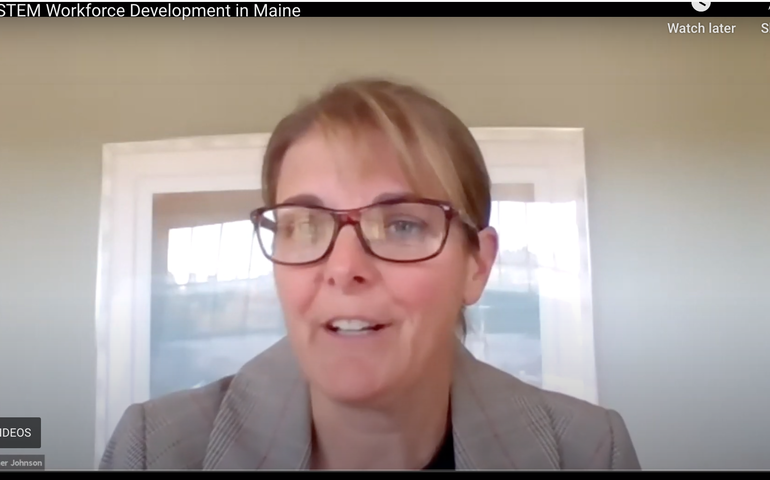Maine is behind in STEM workforce development, but has growth potential
 Screenshot / Courtesy, Maine State Chamber of Commerce
Heather Johnson, commissioner of the Maine Department of Economic and Community Development, discussed the potential for growing the STEM workforce in Maine, during a virtual event hosted by the Maine State Chamber of Commerce’s education foundation and Science is US.
Screenshot / Courtesy, Maine State Chamber of Commerce
Heather Johnson, commissioner of the Maine Department of Economic and Community Development, discussed the potential for growing the STEM workforce in Maine, during a virtual event hosted by the Maine State Chamber of Commerce’s education foundation and Science is US.
Data show that Maine lags the nation as a whole in developing a workforce for science-based and engineering jobs.
But there’s no reason Maine can’t catch up in the science, technology, mathematics and technology — or STEM — fields, said Heather Johnson, commissioner of the Maine Department of Economic and Community Development.
And over the last five years, she added, the life sciences industry has had stronger job growth in Maine than anywhere else in the U.S., which reinforces the state's potential to be a strong STEM player.
Johnson spoke during a recent virtual event focused on STEM workforce development in Maine and hosted by the Maine State Chamber of Commerce’s education foundation and a nonprofit, Science is US.
Science is US brings together leaders in science, engineering, industry, higher education and labor to galvanize a broad, bipartisan political base of support for science and technology.
Human capital
The session was the first in the two groups’ “STEM Workforce Development in Maine” four-part series. The goal of the series is to provide best practices to businesses and stakeholders to help recruit, train and expand the STEM workforce in Maine.
The first session centered on the critical role of STEM in Maine’s economy and explored pathways for expanding the STEM workforce.
A recent report by Science is US found that the majority of Maine’s employment, labor output and state gross domestic product is supported by STEM: 58% of Maine jobs, 66% of Maine’s output and 61% of Maine’s gross domestic product.
STEM-supported employment in Maine generated $4.8 billion in federal tax revenues and $4.7 billion in state and local tax revenues.
But in its 2020 report on science and engineering indicators, the National Science Foundation’s National Science Board found that Maine is behind the nation in other measures. For example:
• Science, engineering and technology employment establishments as a percentage of all: 9.23% in the U.S., 6.78% in Maine.
• Individuals in science and engineering occupations as a percentage of all occupations: 4.89% in the U.S., 3.57% in Maine.
• Research and development as a percentage of gross domestic product: 2.8% in the U.S., 0.84% in Maine.
Johnson said Maine has growth potential to be more competitive in the STEM fields. That work, she said, takes human capital, talent and focus; it doesn’t need proximity to natural resources or to major markets.
Continuum of workforce
“It just takes the ability to develop talent,” Johnson said. “That’s something we are good at and get better at every day.”
Johnson said Maine needs to better align its educational systems — including pre-kindergarten through grade 12, higher education institutions, retraining opportunities, and community and technical schools — to create “a continuum of workforce” that meets the business community’s needs in the STEM economy.
As a state, Maine has been hesitant to spend money on research and development and “a little slow” to attract R&D investment, she said.
“A lot of companies do R&D in other places and not here,” she said.
As Maine thinks about how to attract more of that business here, most of the focus is on developing the workforce, she continued.
She recounted a meeting between her agency and a couple of life science businesses that were thinking about locating in Maine. They weren’t as worried about finding the Ph.D. scientists they would need as about finding enough lab technicians, she said.
From heritage to innovation
Johnson noted that Maine’s new 10-year economic plan, released by Gov. Janet Mills last December, called for building on Maine’s “heritage” industries of farming, forestry and fishing to drive innovation and a diverse economy for the future.
Heritage industries provide a “sweet spot,” she said, for driving innovation and supporting development of a STEM workforce.
For example, the forest products industry has evolved past paper and into sectors such as advanced building materials and bioplastics. The challenge, she said, is to leverage the long experience that’s already built into Maine’s economy to develop new products.
The need for STEM workers is evident in the numbers: For every job filled at a STEM-related company, six go unfilled over the last couple of years.
Filling those jobs, which are expected to grow in number in the future, means developing STEM skills in resident Mainers, keeping them in Maine, and attracting out-of-state STEM students and adults, she said.
Johnson cited the Harold Alfond Foundation’s recent $500 million pledge in charitable grants to Maine schools and organizations to support the goals of Maine’s 10-year Economic Development Strategy by enhancing workforce skills, promoting innovation and strengthening the state’s infrastructure.
The gifts are a major resource that helps Maine stand out as the state works on developing STEM talent, she said.
The Department of Economic and Community Development is looking at tools to align opportunities so that business and learners can find each other; to help students, even from an early age, to understand what a STEM career looks like and how to get there; and to help displaced workers to get jobs available now and in the future.
The average salary for a life science job, she noted, is $87,000, compared with $38,000 for a non-STEM job.
“There are ways for us to move forward,” Johnson said.
The second session of the STEM workforce development in Maine series is scheduled for Thursday, Nov. 12, 1-3 p.m. For more information, click here.














0 Comments